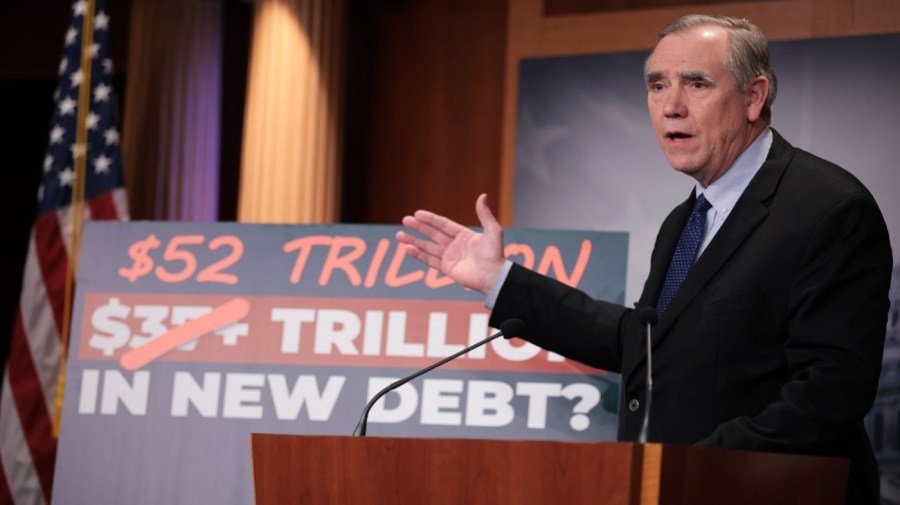
Amid all the tumult in financial markets, investors have been focusing on the fallout from President Trump’s tariffs that are intended to eliminate the U.S. trade imbalance in future years. By comparison, the wrangling over the federal budget has received much less attention.
This is a mistake, in my view, because the current account deficit, which includes trade in goods and services, is linked to the budget imbalance.
As students of economics are taught, the national income accounting identity shows that the current account imbalance is equal to the sum of the federal budget imbalance and the difference between investment and savings in the private sector.
Last year, for example, the U.S. ran a current account deficit of about 4 percent of GDP while the federal budget deficit was 6 percent of GDP. Private sector net saving was positive at 2 percent of GDP.
This relationship helps clarify that Republicans and Democrats should strive to reduce future federal budget imbalances to lower U.S. trade deficits.
Federal debt outstanding has been on an unsustainable trajectory since the 2008 Financial Crisis, rising from less than 40 percent of GDP to 100 percent in 2024. Much of this increase reflects ongoing growth of mandated programs such as Social Security, Medicare and Medicaid, as well as federal programs enacted during the COVID-19 pandemic.
Congressional Republicans are now planning spending cuts totaling $1.5-$2 trillion over 10 years to address this. However, the budget resolution the House of Representatives passed on April 10 also lays the groundwork for extending President Trump’s 2017 tax cuts and for additional tax cuts that total more than $5 trillion.
The nonpartisan Committee for a Responsible Federal Budget estimates the Republican blueprint could add up to $5.8 trillion to the federal deficit over the next decade. If so, it could hinder the Trump administration’s efforts to reduce the U.S. trade imbalance.
The current situation is reminiscent of the mid-1980s, when the U.S. ran a record current account deficit of 5 percent of GDP as the dollar appreciated to a record high. This fueled trade tensions between the U.S. and Japan and European countries.
The Reagan administration argued that Japan was manipulating the yen, and also that Japan and the European countries were restricting U.S. imports via non-tariff barriers. They countered that the U.S. was at fault for running “twin deficits” that kept U.S. interest rates very high and the dollar strong.
The trade conflict subsequently led to two agreements between the U.S. and other G-7 members to ameliorate the dispute. The Plaza Accord in September 1985 was intended to promote an orderly decline in the dollar, while the Louvre Accord in February 1987 was intended to stabilize the dollar after it had fallen considerably.
When the latter agreement was temporarily severed in the autumn over a policy dispute, it culminated in the October 1987 stock market crash, which forced policymakers to resolve their dispute quickly to calm the markets. In the end, the restoration of the U.S. trade balance required a large dollar depreciation and progress in reducing the U.S. fiscal imbalance.
Looking back on what transpired at that time, my concern is that the current dispute between the U.S. and its trading partners could be more difficult to resolve for several reasons.
First, the tariffs President Trump unveiled in his Apr. 2 “Liberation Day” announcement apply to all U.S. trading partners, big and small, and even to countries that run trade deficits with the U.S. Even with the 90-day suspension in reciprocal tariffs, across-the-board duties of 10 percent are still in place and additional duties apply to several product categories.
Second, the negotiating process is more complex today because President Trump prefers bilateral deals to multilateral arrangements. This poses a daunting challenge for Treasury Secretary Scott Bessent, who is tasked with striking numerous deals in a short time.
Third, the most important negotiation is with China. It has been preparing for a trade war ever since Trump imposed duties on its goods in his first term and is determined not to cave to U.S. demands.
Meanwhile, duties on Chinese goods are set at 145 percent. However, President Trump acknowledged this week that tariffs could drop substantially if the two countries can make a deal, although he also qualified that “it won’t be zero.”
There are ultimately two main stumbling blocks to resolving the trade conflict.
One is President Trump’s unshakeable belief that the primary cause of large U.S. trade deficits is unfair trading practices abroad, rather than persistent U.S. saving-investment imbalances, as most economists believe.
The other obstacle is that Democrats and Republicans have been unwilling to compromise to bring federal debt under control. Democrats continue to favor the expansion of social programs that they believe should be financed by the rich, while Republicans are striving to reduce their tax burden by curbing spending.
So, what might a compromise look like?
Bill Clinton was the last president to achieve a budgetary surplus. He did so by reducing federal government spending as a share of GDP from 22.2 percent in 1992 to 18 percent in 2000, while also raising the marginal tax rate on high-income earners from 36 percent to 39.6 percent in 1993. Throughout this period, the U.S. current account deficit was also low, in the vicinity of 1 percent to 2 percent of GDP.
If both parties are unable to reach a compromise to reduce the fiscal imbalance, the private sector of the economy will bear the burden of lowering the trade imbalance. This could occur, for example, if the economy weakened and household savings rose while business investment declined.
However, it would be a more costly way to restore the trade balance than by curbing the budget deficit.
Nicholas Sargen, Ph.D., is an economic consultant for Fort Washington Investment Advisors and is also affiliated with the University of Virginia’s Darden School of Business. He has authored three books, including “Global Shocks: An Investment Guide for Turbulent Markets.”


